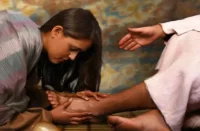In a graphic scene of redemption, CS Lewis depicts a young boy who has unfortunately been turned into a dragon. The boy (Eustace) is largely at fault in this transformation – something which brings his life to a miserable and seemingly unsolvable conclusion. He is, however, confronted by God in the figure of Aslan, the allegorical lion at the center of the Chronicles of Narnia. He is desperate to be healed – and Aslan points to a way forward. He must be washed in a particular pool of water (Lewis’ symbolism is not difficult). But, in the process, he must shed his skin. And so the shedding begins. But, layer upon layer are insufficient. At last, there is nothing for it but for the Great Lion to assist – and he does so with his claws.
Then the lion said — but I don’t know if it spoke — “You will have to let me undress you.” I was afraid of his claws, but I can tell you, I was pretty nearly desperate now. So I just lay flat down on my back to let him do it…. That very first tear he made was so deep that I thought it had gone right into my heart. And when he began pulling the skin off, it hurt worse than anything I’d ever felt. The only thing that made me able to bear it was just the pleasure of feeling the stuff peel off.
It is a striking element to add to a story of conversion and healing – not just a Baptism – but a tearing down of a dragon-suit, a false identity that sought to imprison Eustace and swallow him whole.
 I volunteered for several years in a local alcohol and drug rehab program, teaching about the spiritual life in recovery. There were many “Eustace” characters among the patients. Some were there willingly (even gladly), while others had yielded to the insistence of a judge. Various addictions (opioids were most dominant) had imprisoned them with a false reality that tended to reshape their thoughts. If you place a normal, healthy person in a prison cell, they will naturally want to get out. If, however, the prison cell has been created from within, an artifact of the brain’s addiction to a chemical poison, then you have the bizarre reality of an inmate being fearful of the prison cell’s disappearance. It is a nightmare – a person comes to love the very thing they hate even while hating the thing they love. Restoring them to sanity is a patient work, often with setbacks and failures.
I volunteered for several years in a local alcohol and drug rehab program, teaching about the spiritual life in recovery. There were many “Eustace” characters among the patients. Some were there willingly (even gladly), while others had yielded to the insistence of a judge. Various addictions (opioids were most dominant) had imprisoned them with a false reality that tended to reshape their thoughts. If you place a normal, healthy person in a prison cell, they will naturally want to get out. If, however, the prison cell has been created from within, an artifact of the brain’s addiction to a chemical poison, then you have the bizarre reality of an inmate being fearful of the prison cell’s disappearance. It is a nightmare – a person comes to love the very thing they hate even while hating the thing they love. Restoring them to sanity is a patient work, often with setbacks and failures.
Those experiences (as well as many others through the years) have served as something of a case-in-point of the strange place that sin holds in our lives. Sin is like an addiction – even when we hate it, we find ourselves returning to it again and again. No matter how many versions of the dragon skin we shed, we discover that we still have yet more to go. There is a “surgery” required that is beyond our own ability.
The culture of modernity imagines itself to be a champion of a therapeutic approach to life. “Healing” is popular in an array of forms. The Christian faith is not immune to this cultural predeliction – how could Christianity be opposed to healing? Nevertheless, much of our modern concept of therapeutics, at least on the popular level, remains shallow and devoid of truth. The culture satisfies itself with “making you feel better.” Oftentimes, wanting to “feel better” is precisely the thing that has made someone sick. In a consumer-driven world, feeling better sells. A Christian version of “feeling better” also sells – but at the expense of the gospel.
At the heart of the gospel is the proclamation of the Cross. The great healing event in the life of the Church (and of every Christian) is the Crucifixion itself. The Cross is not restricted to Christ’s death – for every Christian is baptized into His death (Rom. 6:3) We must say with St. Paul, “I have been crucified with Christ” (Gal. 2:20). In CS Lewis’ story of Eustace’s “de-dragoning,” entry into the healing water is accompanied by a “crucifixion” at the hands of Aslan. Eustace is set free by the “claws of God” and bathed in the healing waters.
Within my experience, in the many cases of the treatment of addictions, there was always a point (indeed, often many points) of crisis – a point where moving forward required pain (on many levels). Health and wholeness cannot be found in an endless pursuit of pleasure and in the avoidance of pain. Because all of this is true, great care must be taken in the therapeutic work of the Church. We do not pursue pain for the sake of pain. Kindness, gentleness, empathy – co-suffering – are all required in the fearful work of a soul’s journey through the Cross. But there remains no path to wholeness that is not a path through the Cross.
I recently read an article that contrasted modernity’s “therapeutic” model with a pursuit of the “truth.” Modernity’s therapy is often devoid of truth, being focused on the temporary and its immediate pleasure. This does not deserve the term “therapeutic.” It is malpractice. It is like the “psychic surgeons” of a few years back who pretended to plunge their hands into a patient (with lots of blood and special effects), withdrawing some pretend disease or offending chicken parts. It was attractive to many – promising healing without pain. It was a fake.
What is truly “therapeutic” cannot be divorced from the truth. Indeed, what is truly therapeutic is our reconciliation with the truth of our being. Christ does not make us to be other than who we truly are – but he reveals to us and in us the reality which we are created to be. The loss of our delusions (and all of their dragon suits) comes at the Cross and in the depths of the healing waters of the font.
Source: Glory To God For All Things














Comments